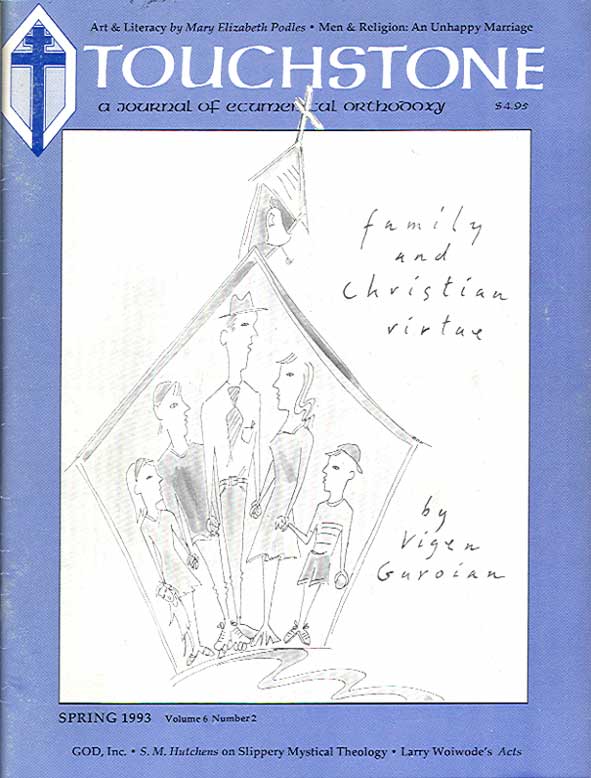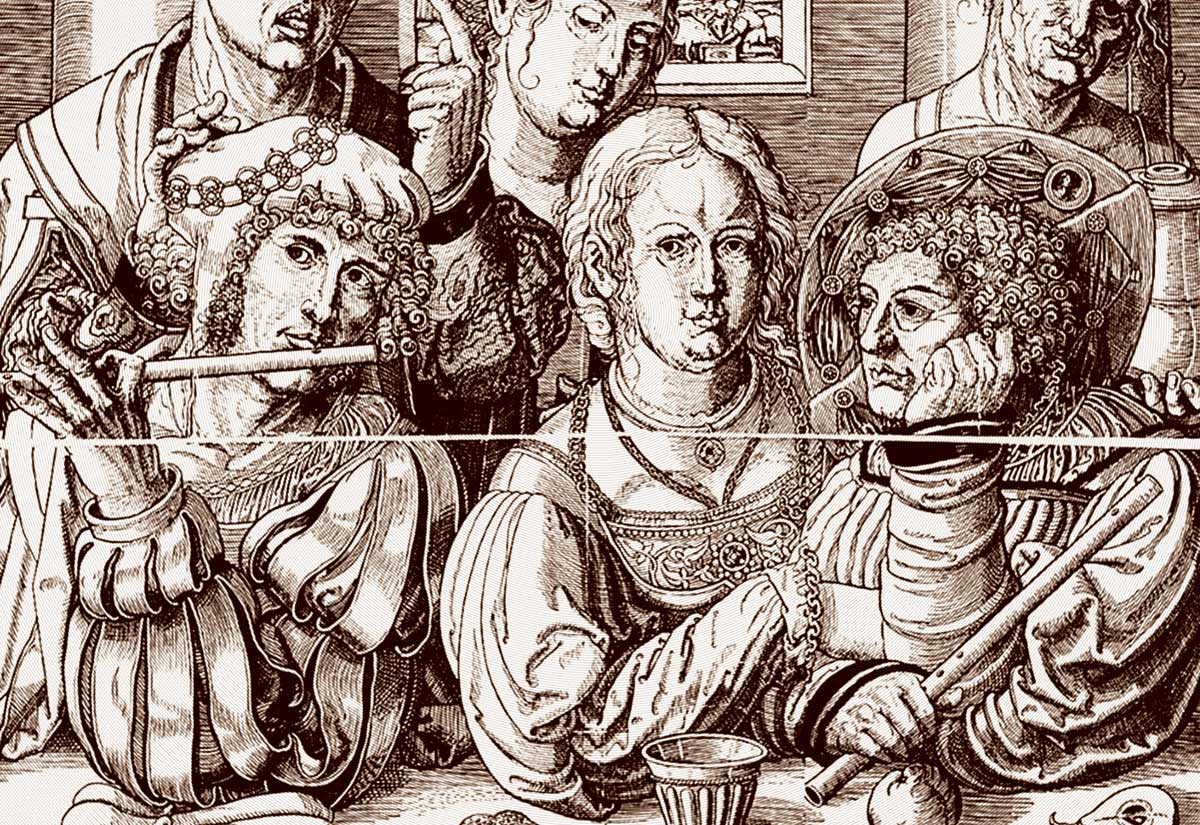Men & Religion
An Unhappy Marriage
by Leon J. Podles
Religious feminists have convinced everyone, or at least themselves and many clerics, that the churches are full of men who want to keep women out. I have noticed through extensive research in high school locker rooms in my younger days, and selected bars in my later years that men are interested in politics, money, football and sex, but not religion. In fact religion in general, and Christianity in particular, has for many a more than slightly effeminate aura. Is this new? How did we get this way? Is there anything that we can do about it? If we ignore it, and let the feminists reconstruct Christianity to suit their tastes, will it matter to anyone except the few who want to take Christianity seriously?
Previous centuries did not have our mania for statistics. We will find no tables in the New Testament conveniently breaking down church membership in Corinth according to age, sex, economic status, and previous attendance at idol temples. We must rely on anecdotes. In mid-eighteenth century England Dr. Samuel Johnson observed that women were more religious than men. Cotton Mather in seventeenth-century America was puzzled that his congregations were mostly women. Throughout the nineteenth century more and more people noticed and commented on this strange phenomenon. In 1890, Howard Bridgman writing in the Dartmouth Review, lamented that “only one young man in twenty in this country is a church member, and that seventy-five out of every hundred never attend church.” The Notre Dame Study of Catholic Parish Life discovered that in American Catholicism of the 1980s:
• More than 85 percent of those involved in ministry to the poor, sick and grieving are women, and social justice and peace efforts draw heavily on women.• More than 80 percent of CCD teachers and sponsors of the catechumenate are women.• More than 80 percent of the members of prayer groups are women.• More than 75 percent of those who lead or take part in adult Bible study or religious discussions are women.• Almost 60 percent of those involved in youth and recreational ministries are women.• 52 percent of parish council members are female.• 58 percent of those identified as the most influential leaders in our 36-parish survey were women.
This study shows that Catholic life is conforming to mainline Protestant patterns, in which at least two-thirds of the congregation are women. All surveys show the same pattern: in Western societies, by all measures of practice and attitude, men are less religious then women. When I attended an Ascension Thursday Johann Sebastian Bach service at a Lutheran church, there was an edifyingly large congregation. However, apart from myself and one Catholic friend, there was only one other man in the congregation of about 300. The black churches take this to an extreme; of their denominations’ congregations, up to 90 percent of members are women. The levels of practice would be even lower if it were not for the influence of women on men. Father Tom Forrest, head of Evangelization 2000 in Rome, estimates that about 80 percent of active Catholics worldwide are women, and of the 20 percent who are men, many if not most are there because of the cajoling of women.
This imbalance between female and male congregants is all the more odd because the religion out of which Christianity grew and whose ethics it took over was Judaism, which was distinctly a male-centered religion. The God of the Jews, unlike any of the pagan gods, was not androgynous, combining male and female, as the gods of the pagans did. He is always spoken of as masculine. The Jews spoke of God this way because they knew that he was transcendent, a being apart from the creation. He was not like the pagan gods, who were immanent, a part of the processes of nature. He was transcendent, and therefore he was holy, separate from the world. Holiness means separation; to make something holy is to separate it from profane use. It is a male category. Psychologists and anthropologists have noticed that male mental processes and life patterns are characterized by analysis and separation, by dichotomy and alienation. The God of the Old Testament is a God of separation; he separates light from darkness, the land from the water, woman from man, the Jews from the pagans, and on the last day, the sheep from the goats, the saved from the damned.
Judaism was also male-centered in that it was a patriarchal religion, indeed the patriarchal religion. The Jews, according to John Miller in Biblical Faith and Fathering, were among the few peoples who managed to place men firmly in the family, and thereby created a true patriarchy, a society ruled by men who used their strength and wisdom to establish and nurture families. Male promiscuity and violence characterized the pagan peoples; the Jews by contrast had faithful marriages and did not destroy their children. A Jewish man thanked God three times a day that he was not born a pagan, a slave, or a woman, because these people were not obliged to the full observance of the Mosaic Law. The Law was such a heavy burden that male Jews had to be reminded that their obligation to observe it was a privilege. The influence of women in religion was seen as largely negative. The Jews had married pagan women, who had brought idolatry into Israel. Women were too susceptible to alien spiritual influences, as we see in the story of Adam and Eve, as well as in the careers of Solomon and Ahab.
Christianity is less exclusively male-centered. The New Testament has a more positive view of the role of women. Mary is sensitive to the Holy Spirit, and conceives the Messiah. She is the only one named in the congregation at Pentecost. Lydia was the first convert in Europe. However, Christianity took over much from Judaism. The Church took over Jewish family and sexual ethics. When the New Testament writers refer to Scripture, they mean the Old Testament, and especially the ethical writings such as Ecclesiasticus. The twelve Apostles were parallel to the twelve sons of Israel. The names for the various ministries in the church were not set in New Testament times, and the distinction we make now between sacraments like ordination and charisms such as prophecy is not clear in the New Testament writings. But it seems that the administration of the Church, what would later be called the priesthood, was male, and therefore continued the Jewish pattern of male headship.
For over a millennium there seemed to be no difference in the participation of men and women in Christianity; at least no one remarked about it. But in the High Middle Ages something peculiar happened to the religious atmosphere. Prophecy had never completely died out in the church. But people who had been given the gift of prophecy were mostly men, and they were given short messages telling people what to do in a specific historical situation. In the High Middle Ages, most prophets were women. They set down their revelations in huge tomes, such as the Book of Margery Kemp and the Liber Celestis of St. Brigid of Sweden. Catherine Emmerich, a nineteenth century prophet, had prophecies that I believe run to several thousand pages. Women began setting the religious tone of the Catholic church. Christ was seen through their eyes.
In the New Testament, Christians, male and female, are spoken of as the sons of God because they are conformed to the image of the Son by the work of the Holy Spirit. The Church as a whole is spoken of as the Bride of Christ, in the same way that Israel as a whole was spoken of as the Spouse of Yahweh. But in these later revelations to women mystics, the individual Christian began to be spoken of as the Bride of Christ, and the relationship between the Christian and Christ was spoken of as a relationship between a woman and a man. Some of you may remember the Catholic Victorian hymn for communion: “And humbly I’ll receive Thee,/ the Bridegroom of my soul/ No more by sin to grieve Thee,/ Or fly Thy sweet control.” Such language and much of the Sacred Heart devotion are a product of the spiritual milieu that had its roots in the women mystics.
As Christ began to be seen more and more through women’s eyes, he was more and more feminized. Women have a tendency to domesticate men, and do not always like the wildness and aggressiveness of the male personality. The image of the soft Christ became more and more dominant. It is not so noticeable in the Madonna and Child, because the child is seen in still close relationship with his mother in a youthful boyishness. However, it is clear that in the paintings of the adult Christ, Christ’s adult masculinity was more and more de-emphasized by post-Renaissance art. Leo Steinberg notes that the Middle Ages and the Renaissance had been rather frank about Christ’s body and even his genitals, an attitude which he examines in The Sexuality of Christ in Renaissance Art and Modern Oblivion. Steinberg is slightly mistaken, however. It was not precisely Christ’s sexuality, but his masculinity, that painters were interested in. His genitals are of course the most obvious sign of his masculinity. The artists used a symbolic language of gestures and juxtapositions to explore the meaning of Christ’s masculinity. The connection that the artists were interested in, even in the paintings of Mary and her child, is that of masculinity with sacrifice.
Leon J. Podles holds a Ph.D. in English from the University of Virginia, has worked as a teacher and a federal investigator, and is president of the Crossland Foundation. He is the author of The Church Impotent (Spence), Sacrilege (Crossland Press), and Losing the Good Portion: Why Men Are Alienated from Christianity (St. Augustine Press). Dr. Podles and his wife have six children and live in Baltimore, Maryland. He is a senior editor of Touchstone.
subscription options
Order
Print/Online Subscription

Get six issues (one year) of Touchstone PLUS full online access including pdf downloads for only $39.95. That's only $3.34 per month!
Order
Online Only
Subscription

Get a one-year full-access subscription to the Touchstone online archives for only $19.95. That's only $1.66 per month!
bulk subscriptions
Order Touchstone subscriptions in bulk and save $10 per sub! Each subscription includes 6 issues of Touchstone plus full online access to touchstonemag.com—including archives, videos, and pdf downloads of recent issues for only $29.95 each! Great for churches or study groups.
Transactions will be processed on a secure server.
more from the online archives
calling all readers
Please Donate
"There are magazines worth reading but few worth saving . . . Touchstone is just such a magazine."
—Alice von Hildebrand
"Here we do not concede one square millimeter of territory to falsehood, folly, contemporary sentimentality, or fashion. We speak the truth, and let God be our judge. . . . Touchstone is the one committedly Christian conservative journal."
—Anthony Esolen, Touchstone senior editor










